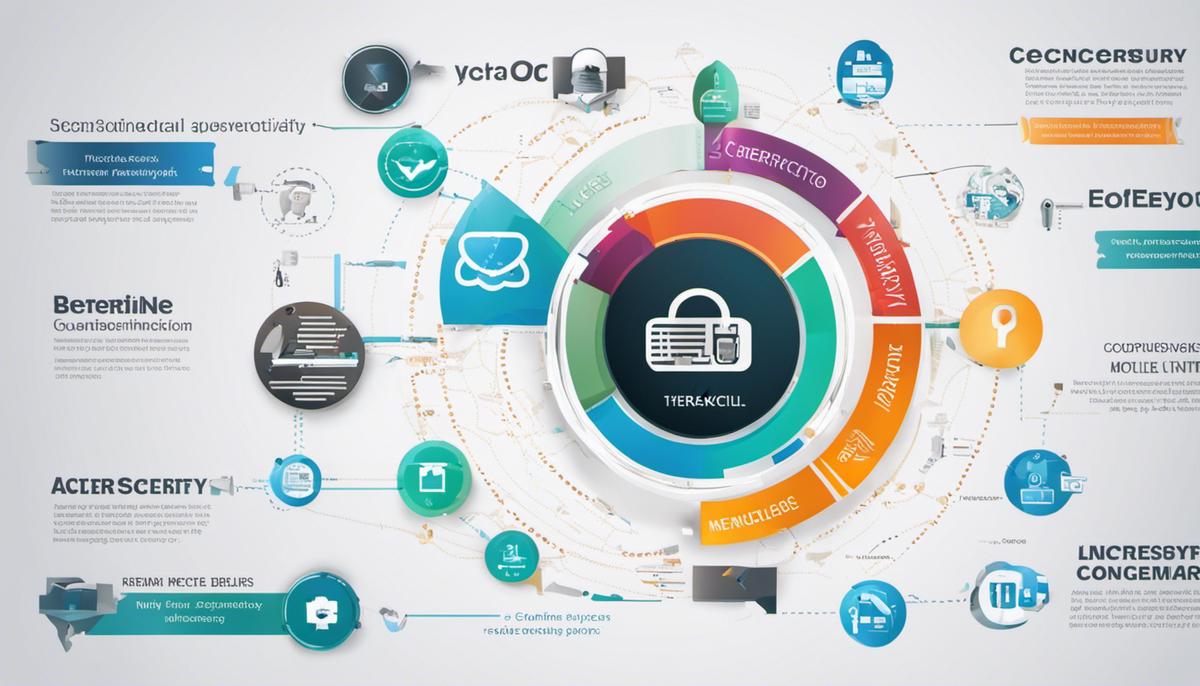Managing cybersecurity incidents, detecting threats in a timely, efficient manner, devising preventive measures, and establishing an effective response strategy are crucial for individuals, small businesses, and multinational corporations. This discourse delves into these key elements, unraveling the complexities of the cyber world, methods to identify potential dangers, best practices for circumventing these global threats, and how to manage effectively if a security breach does occur.
Understanding Cybersecurity Incidents
Understanding Cybersecurity Incidents: An Unavoidable Threat for Today’s Businesses
In our era of digital enterprise, one issue towers above the rest – cybersecurity. Of all the perils that a business entity might encounter today, none is more undiscriminating, unpredictable, and potentially damaging than a cybersecurity incident. As we forge ahead into the complexities of this digital age, it’s paramount for businesses to stay informed and proactive against the ever-evolving challenges of cybersecurity.
‘Cybersecurity incident’ is a broad term encompassing any event that threatens the confidentiality, integrity, or availability (CIA) of an information system or the information housed within it. This could include phishing attacks designed to steal sensitive data, ransomware that holds systems hostage, or Distributed Denial of Service (DDoS) attacks designed to cripple a company’s online presence.
One may question why cybersecurity incidents have emerged as such a dominant concern for businesses. To grasp this, let us dive a bit deeper into the ramifications these incidents bring. Firstly, the immediate impact of a cybersecurity incident can be devastating. Businesses may suddenly find themselves powerless, with vital services and operations halted or slowed down considerably.
Subsequently, the financial toll associated with cybersecurity incidents is hefty. According to a report by Accenture, the average cost of cybercrime for an organization increased from $1.4 million to $13.0 million over the last five years. The stark rise in costs showcases the escalating danger that these incidents pose.
But the financial burden isn’t the only concern. There’s also the formidable task of rebuilding reputation and regaining customer trust post-incident. This can be an uphill battle, as the public is increasingly cautious about how companies handle their data.
Moreover, legislative requirements have evolved in response to the growing cybersecurity threat. Regulations like the General Data Protection Regulation (GDPR) in the EU and the California Consumer Privacy Act (CCPA) in the US impose substantive penalties on organizations that fail to protect customer data. These penalties can serve to increase the already substantial cost of a cybersecurity incident.
Lastly, the prevalence and sophistication of these attacks are growing. Tech enthusiasts, such as hackers and data thieves, have a continuously expanding toolkit of exploits at their disposal. From Zero-Day exploits that capitalize on software vulnerabilities to social engineering hacks that manipulate people into revealing confidential information, cyber threats are anything but static.
Cybersecurity is a dynamic battleground where businesses must defend against an ever-changing enemy. Investing in preventive measures, training employees on potential threats, and constructing a robust incident response plan are crucial steps in proactively countering cybersecurity incidents. As we continue to navigate through the database-laden labyrinth of the modern world, the importance of a competent cybersecurity strategy only stands to grow. In the high-stakes world of cyberspace, the adage holds true – the best defense truly is a good offense.
Identification and Analysis of Cybersecurity Incidents
Navigating Cybersecurity Incidents: Identification and Analysis
In the modern digital age, the continuity and success of businesses heavily rely on robust and competent cybersecurity strategies that include not just preventive measures but also an effective plan for identifying and analyzing cybersecurity incidents. To elaborate, it’s more than just minimizing occurrences; it’s about being well-educated on the necessary actions post-incident.
A crucial initial step in addressing cybersecurity incidents is prompt identification. This requires vigilant monitoring of network activity and identifying anomalies that may indicate malicious actions. Utilization of top-notch firewall systems, intrusion detection systems (IDS), and 24/7 network monitoring are effective in this endeavor.
Deciphering genuine incidents from false positives is also essential, thus demanding keen scrutiny of alerts. Unusual system activities, repeated failed login attempts, and unexpected data transfers are among the prominent signs that could signify a cybersecurity incident.
Conducting comprehensive log analysis is another effective way of identifying incidents, given that these logs document each activity within a system. Using this tool, analysts can identify patterns that may hint at a malicious intrusion or activity. Having a Security Information and Event Management (SIEM) system in place can also provide an organized view of the logs from multiple sources, making the incident identification process efficient.
Having identified a potential cybersecurity incident, the next step would be to analyze the threats thoroughly. The aim here is to understand the scope, impact, and potential origin, essentially, the ‘who,’ ‘what,’ and ‘where,’ as well as to provide insights into potential remediation and recovery methods.
The forensic analysis should be initiated promptly post-identification. Here, experts scrutinize the incident, track the intruder’s path, and measure the extent of the data breach if there’s any. Tools such as Remote Forensics Software can aid in collecting and preserving digital evidence.
In parallel to the forensic analysis, a malware analysis should also be conducted. This helps in understanding if the incident was due to a known malware or a zero-day exploit. Different methods, such as static analysis (studying malware without executing it) and dynamic analysis (observing malware during execution) can be employed for a comprehensive understanding of the malware’s behavior.
Risk assessment is another important facet of the analysis stage. This involves determining the liability associated with potential or existing security gaps and understanding how the discovered incident can affect the organization.
This entire procedure of identifying and analyzing cybersecurity incidents is cyclic in nature and requires vigilant reiteration. The information obtained post-analysis should also be used to improve the organization’s cybersecurity posture. Remember, a proactive stance is far better than reactive measures when safeguarding digital assets. This is essentially the essence of a competent ‘cybersecurity strategy’ in this interconnected era brimming with potential cyber threats.

Preventive Measures Against Cybersecurity Incidents
To advance the fortification against cybersecurity incidents, several steps can be taken that go beyond the basic foundational cybersecurity strategies. Securing digital landscapes necessitates a multi-tiered approach integrating various security measures to effectively defend against different types of threats.
The first and foremost is adopting a proactive approach towards cybersecurity. This can be achieved by continuous monitoring and regularly auditing the systems in place. Auditing helps in the identification of potential vulnerabilities that can be patched before they are exploited by hackers. Security testing tools such as vulnerability scanners and penetration testing tools can come in quite handy in this regard.
Organizations should also invest in advanced threat intelligence tools and services. Threat intelligence can provide useful insights into the latest cyber threats, their sources, and tactics, thus helping organizations to stay one step ahead of the attackers. By understanding the threat landscape, organizations can optimize their security mechanisms to ward off potential cyber incidents.
Encryption cannot be overlooked when discussing effective measures to prevent cybersecurity incidents. By encrypting sensitive data, even in the event of a breach, the data will be of no use to the hackers as it would require a crucial decryption key to convert the data into a usable form. Encryption should be applied to data both at rest and in transit for maximum data security.
Multi-factor authentication (MFA) is another viable measure to prevent unauthorized access to systems and data. MFA uses multiple layers of authentication factors, making it almost impossible for hackers to break through. While it does add an extra step for the users, the added security it provides justifies this minor inconvenience.
Cybersecurity is a field that constantly evolves, and so should the people tasked with securing the digital estate. Hence, continuous training and education for the IT staff is of utmost importance. They should be made aware of the latest security practices technologies, and how to respond effectively in the event of a cybersecurity incident.
Lastly, adopting a Zero Trust Security model could reinforce the cybersecurity defenses. Originally coined by Forrester Research, this model operates on the principle of “Never Trust, Always Verify”. The Zero Trust model ensures that each service, user, or system must be authenticated and validated, even if it is already inside the organization’s network.
All these cybersecurity measures, while complex to implement and maintain, could significantly reduce the risk of falling victim to a cyber incident. The cost of not implementing them is certainly a lot higher, making them essential components of any effective cybersecurity strategy. The future of cybersecurity rests on automation, smart technologies, continued education, and a robust, proactive approach to security. In this constantly evolving digital era, there is simply no room for complacency.

Response and Recovery from Cybersecurity Incidents
Swift and precise incident response is as critical to the IT strategy of an organization as having robust cybersecurity defenses in place. When a cybersecurity incident strikes, this calls for a systematic, well-choreographed response that seeks to minimize damage and expedite recovery. Navigating this complex terrain requires an understanding of the key steps involved. Here’s a beginning-to-end guide.
Initiating the Response
Once an incident is identified and confirmed, there’s no time to spare. The incident response team must rise to action immediately. A delay could compound the damage and lead to dire consequences such as data loss, financial impact, and reputational harm. The incident response team calls upon various segments of an organization, from IT to HR, where each participant should know their role and responsibilities in controlling the situation.
Containing the Breach
The paramount task at hand is to contain the breach, preventing the spread of the attack to unaffected systems. This containment strategy depends on the type of incident and its gravity. This could involve disconnecting affected systems or networks, allocating additional resources to overwhelmed systems, or implementing temporary countermeasures to thwart the attacker.
Eradicating Threats
After containment, the focus shifts to dealing with the source of the attack. Technicians work assiduously to locate and remove malicious code, if, reform compromised systems, and secure any vulnerabilities exploited by the attacker. A testing regimen ensures eradication measures hold up against recurring attacks while hardened security checks further bolster the defenses.
Recovery and Restoration
Next, systems are carefully restored and returned to normal operating conditions. Data recovery from backups systems and software updates constitute this stage. The gradual re-introduction of systems into a production environment with heightened monitoring helps spot any secondary or hidden attacks that may have been planted by perpetrators.
Post-Incident Activity
Following the chaos, organizations need to regroup and learn. A thorough debriefing involves discussing the incident’s timeline, actions taken, decisions made, and their impact. The key is to take the incident as a learning experience. Examining how the incident occurred and assessing its handling uncovers aspects needing improvement. Adjustments are made, preventive measures are put in stronger places, and response strategies are enhanced.
Long-Term Strategies
To tackle evolving cyber threats, IT departments must stay vigilant by regularly running risk assessments penetration tests, and auditing IT infrastructure for security gaps. Besides, adopting adaptive security architectures designed to predict, prevent, detect, and respond to security threats is crucial.
In the shifting digital landscape, necessitating the incorporation of the latest cybersecurity tools and techniques, it becomes indispensable to keep abreast of regulatory changes, industry best practices, and technologies like artificial intelligence and machine learning, which are redefining cybersecurity strategies.
Building Resiliency
In the post-incident scenario, organizations must design and implement an IT resilience plan. This includes maintaining a keen focus on digital transformation and cultivating an IT culture that is resilient by design. Integrating cybersecurity into all aspects of technology planning and decision-making ensures the organization stays current with the ever-changing threat landscape.
Endlessly evolving threat vectors require even well-prepared organizations to envision encountering a cybersecurity incident. The defining factor for an organization is its ability to respond and recover proficiently. Indeed, the keys to recovering from an incident lie in the effectiveness of the antecedent practices and protocols, fortified by continuous learning and adaptation.

Moving forward, it’s evident that robust cybersecurity measures are no longer a mere addition but a necessity for the digital survival of businesses and individuals alike. Armed with the knowledge of potential threats, equipped with effective tools for early detection and analysis, and enabled with comprehensive preventive and recovery strategies, we can create a more secure, resilient digital infrastructure. Ultimately, cybersecurity is not a standalone activity; it’s an ongoing endeavor, a collective commitment that requires constant monitoring, adapting, and improving. Thus, everyone has a role to play in this enormous task of conquering cyber threats.

